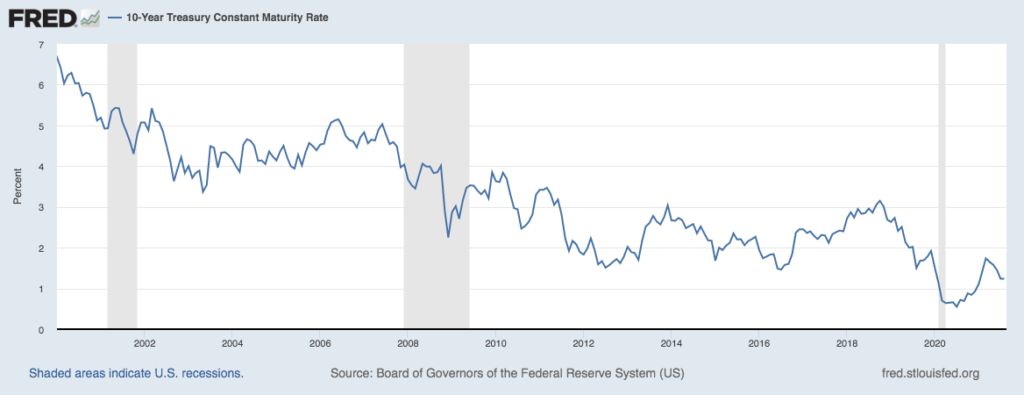by William
Henderson, Vice President / Head of Investments
U.S. stocks
finished last week modestly down across the board. The
Dow Jones Industrial Average fell -1.1%, the
S&P 500 Index lost -0.6%,
and the NASDAQ fell by
-0.7%. The
modest losses for the week did not take much from full
year 2021 returns, which remain healthy across
all three indexes. Year-to-date,
the Dow Jones Industrial Average has returned +16.1%,
the S&P 500 Index +19.4% and the
NASDAQ +14.7%. Treasury
bonds changed very
little last
week with
the yield on the 10-year U.S. Treasury
dropping two basis
points to 1.26% from 1.28% the
previous week. 1.26% on the 10-year U.S.
Treasury is a full 48 basis points
lower than the 1.74% yield level hit in March of this year. Further,
traders and equity markets certainly
were caught off guard last week when
the FOMC meeting minutes were
released and showed that the Central Bank was considering a “tapering” of bond
purchases. This had
to have been an “Emperor Has No Clothes” moment as the worst kept secret on
Wall Street was revealed. Everyone, everywhere
expects the Fed to taper its bond purchases, so why did the markets
sell off?
As we planned this
week’s market commentary, it was agreed that we would not follow the herd and
mention the “Taper Tantrum of 2013,” however, it
seems we failed. This event refers to the 2013 modest sell off in bonds
resulting from the Fed announcement that it would finally reduce bond purchases
it had been making since 2008 because of the Great Financial Crisis. Looking
at the chart below from the Federal
Reserve Bank of St. Louis, the “event” of 2013 looks more like
a buying opportunity in bonds rather than a blood bath for bond traders as
the 10-year U.S. Treasury hit 3.04% at the end of 2013.

The point is that everyone knew in 2013 that the Fed needed to slow its bond purchases and allow the markets to return to somewhat normal trading patterns. Just like 2021 – everyone knows the Fed must slow its purchases. So, again, why did the markets sell off on last week’s news from the Fed meeting minutes? The markets are most likely seeing the gradual end to the massive monetary stimulus that the Fed has provided since March of 2020 and that simply removes a comfortable layer of protection and adds an unsettling layer of uncertainty.
There are two opposing thoughts: First, actions
by the Fed to reduce its
bond purchases thereby starting to remove monetary stimulus, shows the economy
is well on its way to a solid recovery. This is healthy news and should
eventually result in strong
market performance. Second and more worrisome
was the Fed’s last-minute change
to its annual symposium in Jackson Hole, Wyoming, to
a virtual event rather than the previously planned in
person event. The Fed’s decision to cancel
this live event is certainly indicative of wider
implications from the spiking in cases of delta-variant of COVID-19 and signs
of overall weakness in economic activity. Data
released from the Transportation Security Administration last Friday showed
a slowdown in travel, with the number of people passing through TSA checkpoints down
10% from a mid-July high. In our opinion, one could certainly brush off
this drop in travel as typical of the summer travel season ending and the “back
to school” season starting. Either way,
it is information and activity that the market must digest
and then react to in one way or another.
Just
like we need things to write about each week, so do the business news channels
needs things to talk about every day all day. Economic noise and
information are widely
available and overly celebrated. We like to focus on long-term trends like the 50-year growing
GDP of the United States, favorable demographic trends in the
U.S. compared to other developed countries, and finally, long-term performance
of stock and bond markets. Keep focused on your investment and ignore
the noise.
